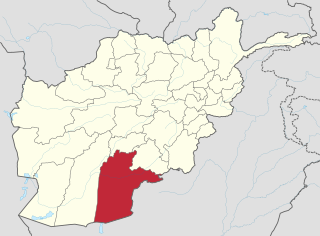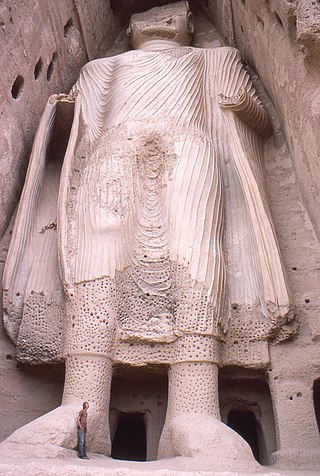
Afghanistan, officially the Islamic Emirate of Afghanistan, is a landlocked country located at the crossroads of Central Asia and South Asia. Referred to as the Heart of Asia, it is bordered by Pakistan to the east and south, Iran to the west, Turkmenistan to the northwest, Uzbekistan to the north, Tajikistan to the northeast, and China to the northeast and east. Occupying 652,864 square kilometres (252,072 sq mi) of land, the country is predominantly mountainous with plains in the north and the southwest, which are separated by the Hindu Kush mountain range. Kabul is the country's largest city and serves as its capital. As of 2021, Afghanistan's population is 40.2 million, composed of ethnic Pashtuns, Tajiks, Hazaras, Uzbeks, Turkmens, Qizilbash, Aimak, Pashayi, Baloch, Pamiris, Nuristanis, and others.

Kandahar is a city in Afghanistan, located in the south of the country on the Arghandab River, at an elevation of 1,010 m (3,310 ft). It is Afghanistan's second largest city after Kabul, with a population of about 614,118. It is the capital of Kandahar Province as well as the headquarters of the Taliban, formally known as the Islamic Emirate of Afghanistan. It is also the centre of the larger cultural region called Loy Kandahar.

MullahMuhammad Omar was an Afghan Islamic revolutionary who founded the Taliban and served as the supreme leader of Afghanistan from 1996 to 2001. Following the ouster of his government by the United States in 2001, he went into hiding and avoided capture until his reported 2013 death from tuberculosis.

Zabul is one of the 34 provinces of Afghanistan, located in the south of the country. It has a population of 249,000. Zabul became an independent province from neighbouring Kandahar in 1963. Historically, it was part of the Zabulistan region. Qalat serves as the capital of the province. The major ethnic group are Pashtuns. Primary occupations within Zabul are agriculture and animal husbandry.

Ahmed Wali Karzai was a politician in Afghanistan who served as Chairman of the Kandahar Provincial Council from 2005 until his death. He was the younger paternal half-brother of former Afghan President Hamid Karzai and an elder of the Popalzai tribe. Wali Karzai formerly lived in the United States, where he managed a restaurant owned by his family. He returned to Afghanistan following the removal of the Taliban government in late 2001. He has been accused of political corruption and was allegedly on the CIA payroll. He was assassinated by one of his close bodyguards, Sardar Mohammad, on 12 July 2011.

Farah is one of the 34 provinces of Afghanistan, located in the southwestern part of the country next to Iran. It is a spacious and sparsely populated province, divided into eleven districts and contains hundreds of villages. It has a population of about 563,026, which is multi-ethnic and mostly a rural tribal society. Farah's population is dominated by Pashtun (80%) tribesmen although Tajiks and a small minority of Shi'a Hazaras can also be found in the countryside. The Farah Airport is located near the city of Farah, which serves as the capital of the province. Farah is linked with Iran via the Iranian border town of Mahirud. The province famous tourism sites include Pul Garden, New Garden, Kafee Garden, shrine of Sultan Amir and Kafer castle are from sightseeing places of Farah province

Kandahār is one of the thirty-four provinces of Afghanistan, located in the southern part of the country, sharing a border with Pakistan, to the south. It is surrounded by Helmand in the west, Uruzgan in the north and Zabul Province in the east. Its capital is the city of Kandahar, Afghanistan's second largest city, which is located on the Arghandab River. The greater region surrounding the province is called Loy Kandahar. The Emir of Afghanistan sends orders to Kabul from Kandahar making it the de facto capital of Afghanistan, although the main government body operates in Kabul. All meetings with the Emir take place in Kandahar, meetings excluding the Emir are in Kabul.
Farah is the capital and largest city of Farah Province in western Afghanistan. It is located on the Farah River, close to the border with Iran. It is one of the largest cities of western Afghanistan in terms of population, with about 1.5 million people living in its urban area.

Arghandab is a river in Afghanistan, about 400 km (250 mi) in length. It rises in Ghazni Province, west of the city of Ghazni, and flows southwest passing near the city of Kandahar, and then joins the Helmand River 30 km (19 mi) below Grishk. In its lower course, it is much used for irrigation, under the control of the Helmand and Arghandab Valley Authority, and the valley is cultivated and populous; yet the water is said to be somewhat brackish. It is doubtful whether the ancient Arachotus is to be identified with the Arghandab or with its chief confluent the Tarnak, which joins it on the left 50 km (31 mi) southwest of Kandahar. The Tarnak, which flows south of Kandahar, is much shorter and less copious.

Buddhism, an Indian religion founded by Gautama Buddha, first arrived in modern-day Afghanistan through the conquests of Ashoka, the third emperor of the Maurya Empire. Among the earliest notable sites of Buddhist influence in the country is a bilingual mountainside inscription in Greek and Aramaic that dates back to 260 BCE and was found on the rocky outcrop of Chil Zena near Kandahar.

Operation Medusa was a Canadian-led offensive during the second Battle of Panjwaii of the War in Afghanistan. The operation was fought primarily by the 1st Battalion, The Royal Canadian Regiment Battle Group and other elements of the International Security Assistance Force, supported by the Afghan National Army and a team from the United States Army's 1st Battalion, 3rd Special Forces Group (Airborne) augmented by A Company, 2nd Battalion, 4th Infantry Regiment of the 10th Mountain Division. Its goal was to establish government control over an area of Kandahar Province centered in the district of Panjwayi some 30 kilometres (19 mi) west of Kandahar city. A tactical victory, it resulted in the deaths of 12 Canadian soldiers; five during the major combat operations, five in bombings, and two in a mortar/RPG attack during the reconstruction phase of the operation. Fourteen British military personnel were also killed when their plane crashed. Despite suffering a brutal battlefield defeat, the Taliban retained their presence in Kandahar province and did not lose their will to fight, leading to the subsequent Operation Falcon Summit. Nonetheless, Operation Medusa was at the time the most significant land battle ever undertaken by NATO.
Shīnḍanḍ is a town and the center of the Shindand District, Herat Province, Afghanistan. It is located at 33.3036°N 62.14°E at 1,066 m altitude on the Harut River. The Shindand Air Base is located about 15 miles northeast of the town.
The following lists events that happened during 2002 in Afghanistan.
Operation Dragon Strike was a NATO counter-insurgent mission in Kandahar province, Afghanistan, against Taliban forces, which started on September 15, 2010.
Baladay is a village in Kandahar Province, in southern Afghanistan. The village lies on the open plain south of Kandahar city. To the north is Shir-e Sorkh and to the southeast is Zaker-e Sharif. It contained 54 houses in 1880. Its altitude ranges between 42 and 65 metres. Most of the inhabitants are involved in agriculture, working on fine orchards and vineyards. The villagers obtain their water from the Naoshijan canal.

Siah Chub Kalay is a village in Zabul Province, in southern Afghanistan, roughly 100 miles northeast of Kandahar. It was the site of a battle of the Operation Enduring Freedom between the Taliban and the coalition forces in early June 2004 after a convoy was ambushed. During eight days of intense fighting, more than 80 Taliban fighters were killed and eight Marines wounded.
Khosrow Sofla was a village in the Arghandab District of Kandahar Province in southern Afghanistan that was demolished by the United States Army in October and November 2010. After experiencing high casualties resulting from firefights and improvised explosive devices (IEDs) outside the village, Lieutenant Colonel David S. Flynn of the American 1-320th field artillery, a part of the 101st Airborne Division, ordered villagers to evacuate Khosrow Sofla, Khosrow Ulya, Tarok Kolache, and Lower Babur and used aerial bombardment to partially or wholly destroy the villages.

Hibatullah Akhundzada, also spelled Haibatullah Akhunzada, is an Afghan Deobandi Islamic scholar, cleric, and jurist who is the supreme leader of Afghanistan. He has led the Taliban since 2016, and came to power with its victory over U.S.-backed forces in the 2001–2021 war. A highly reclusive figure, he has almost no digital footprint except for an undated photograph and several audio recordings of speeches.













